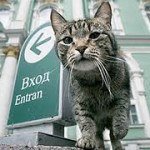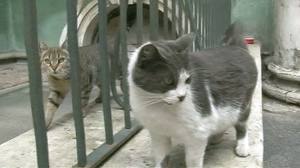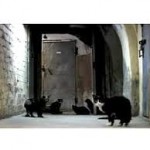Russia’s famous Hermitage Museum has an unusual line of defense of the four-legged variety.
The Guards of the Russian Crown Jewelry
The most famous museum in Russia, the State Hermitage in the heart of Saint Petersburg, is guarded by 70 cats. Visitors don’t usually see these “employees” in the exhibition halls of the magnificent buildings of the Hermitage. They work in the labyrinths of the basement, where the maintenance network is located, hunting rats and mice. For the last 200 years, these cats have been an inextricable part of Russia’s greatest museum.
Entering the museum I come across a big ginger cat, who is not in a hurry, rubbing his side against the pillar in front of the main staircase. “Look, he’s one of our guards. Persik keeps order here,” supervisor Tatyana Nikolayevna Danilova tells me, smiling. “He used to be a very obedient cat, but now he has become a hooligan, a real menace to the cleaners,” Tatyana jokes.

Persik first appeared half a year ago when he was brought to the museum by one of the employees. He was in a very weak condition, having been a victim of animal cruelty in a market place in Saint Petersburg. The Hermitage staff looked after the cat by feeding him and letting him rest. Persik eventually regained his strength and now every morning he leaves the Hermitage courtyard for a walk along the embankment of the river Neva, in front of the grand Winter Palace. He returns to wait for the museum staff to arrive, with the hope of receiving a few tidbits. After having his snack, Persik walks calmly into the museum, through the main entrance with the foreign tourists. However, the supervisors don’t allow the Hermitage cats into the exhibition rooms. If they find any uninvited guests, they escort them to a corridor, where only personnel are allowed.
In the old Winter Palace the first cats appeared during the reign of Empress Elizabeth, who was very annoyed by the number of mice and rats in the residence. As a present she received five selected rat hunters from the town of Kazan in Tatarstan. Until the October revolution in 1917 the Hermitage cats were looked after by special servants, because it was considered the Tsar’s will and they were granted a monthly allowance for food from the empire’s treasury.
In Soviet times state finances changed and suddenly there weren’t any more resources available for the loyal guards of Hermitage. The cats had to be fed and taken care of by volunteers.
During the siege of Leningrad in World War II all of the Hermitage cats died. When the war was finally over in 1945, two railway wagons of new cats arrived in Leningrad. In the late 1960’s a new threat endangered the guards of the Hermitage: overpopulation. The employees of the museum had to catch the majority of the cats and transport them to the surrounding country side.
In the last few years the number of cats has risen dramatically, mainly because many homeless animals have been brought in to seek asylum in the premises of Hermitage. The staff has launched a campaign to find new homes for the additional guards and after interviewing potential hosts, 15 cats have been sent to good homes. The employees of the Hermitage now collect money to help take care of their four-legged friends.

Van Dyck
The most popular gathering place for employees and cats is the wooden bench under a wide window, from which there is a view of one of the Hermitage’s courtyards. In the past, when there was no cattery in the museum, the cats used to give birth there. A cat named Vaska, who often sleeps on the bench, is the favorite son of the museum employees. “Vaska is our grand old man. He’s already 14, a very affectionate and noble cat. He just loves art. If you’ve lost sight of him, you can bet that you’ll find him in the exhibition hall, though we usually catch him before he makes it to the labyrinthine rooms,” laughs Tatyana Danilova. However, it’s very difficult to totally deny access for the cats to the exhibition premises. Many times the Hermitage supervisors have found runaway guards strolling amongst the visitors. Last autumn, an alarm bell called Danilova to an exhibition room where the art and culture of ancient Egypt is presented. Entering the room she heard someone yelling terribly. A cat named Chipa was stuck between a showcase and a plinth. Tatyana immediately called the local fire department. Chipa was finally set free from the trap by two strong firemen, who lifted the metallic plinth with the help of a crowbar.
Tatyana also remembers a case when one curious cat climbed from the basement through a ventilation tube up to the second floor of the New Hermitage, where the exhibition room of the famous Dutch artist Anthony Van Dyck is located. The exhibition supervisors tried to lure the cat with the help of food, but all efforts were useless. Finally, the hungry animal surrendered to the staff after spending two exhausting weeks in the museum’s ventilation system. From that day on the cat was called Van Dyck.
The Hermitage Cattery
This is a part of the State Hermitage Museum that is not mentioned in any guide books and where no tours are arranged. Life behind the scenes is familiar only to the

staff and their relatives. A lot of things happen here in the labyrinths of the basement. There are endless corridors, spiral staircases and steel doors. Each steel door has a hole in it, giving the cats easy access to the courtyards outside. In the Hermitage there are eight places for feeding cats, but most of them live in the cattery. Here the staff recognizes them not only by their looks, but also by their characteristics and habits. “This is our happy couple Kuzya and Chita. They have been together ever since they met”, Tatjana Danilova tells me while pointing to a harmonious looking couple lying next to each other in a ventilation tube. “Mashenka, where have you been? I thought that you were missing”, she happily asks the cat who is walking towards us. Suddenly we see a black and white cat leaning out of a cardboard box, he starts stretching lazily in front of us. Handicapped Timur is the only non-castrated cat in the Hermitage. He came to the museum with an open fracture in his front paw. Despite the operation, he still limps lightly. Tatyana thinks that it is not be possible to castrate him, since he would gain weight after the operation, with serious consequences for his once injured leg.
We walk down to the basement via a stone staircase. We enter a little room and have to bend down to avoid hitting our heads on the half round ceiling. Cats are sitting like exhibition items on the ventilation tubes. Tatyana starts rustling food packages in her hands, and they immediately gather around her to wait for their meal.
The cattery of the Hermitage is simultaneously a kitchen, a clinic and a room for having a rest. Here you can find stove, refrigerator, freezers, storage for food and sleeping baskets. Every morning the museum employees boil buckwheat and rice and add fish or meat to the cat’s porridge. “Sometimes we also buy chicken and pork liver or tripe to add to the porridge. The cats also love grated carrots with sour cream or fermented milk. In the afternoon we feed them dry cat food”, Tatyana Danilova explains.
At the exit of the museum I encounter one of the cats, who is comfortably having a rest on the head of a statue. The sun nicely warms the metal of the monument and the cat is enjoying his life, neglecting the conventions of ordinary beings. There is something special, something extraordinary about the Hermitage cats.